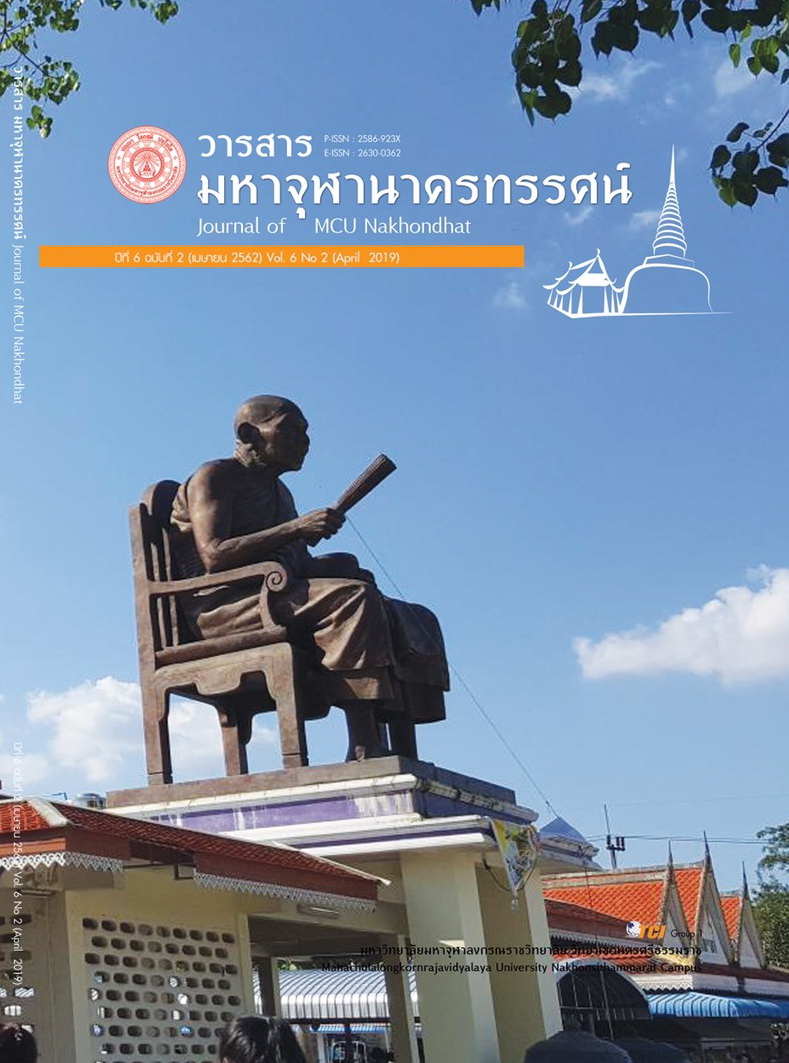PARTICIPATORY RESPONSIBILITY MODEL OF BUDDHIST CHARITY SCHOOL STUDENTS IN BUDDHISM
Main Article Content
Abstract
Research The model for creating participatory responsibility of the students of the Buddhist temple school with the objectives 1) to study the concepts, theories, principles of development of participatory responsibility of students at the secondary level 2) to create a model of participatory responsibility development of students in secondary schools and 3) to propose a model of responsibility development Participation of students in the charity school of Buddhist temples The researcher used mixed methodology. The first step was qualitative research in order to study the operational conditions, create a participatory responsibility By interviewing 7 images / person and creating a model by discussing the expert group of 12 images / person and quantitative research to evaluate the model by the actual practice group, namely, personnel in the charity school of the Buddhist temple in the south, which is a sample of 265 people. In the research, the focus group interview form And evaluation form.
The research results found that:
- Principles of development of participatory responsibility for students at the secondary level, for the charitable schools of the Buddhist temples in the southern region, it is obvious that every school focuses on moral development. The ethics of students as well because there is a policy of being a charity school of Buddhist temples that must emphasize morality and ethics. The virtue is Participatory responsibility for the charitable school group of Buddhist temples in the southern region, students have a duty and participatory responsibility that must be followed as follows: 1) Responsibility to the community 2) Responsibility to parents 3) Responsibility to teachers and schools and 4) Responsibility to friends
- The results of the draft of the model for creating participatory responsibility of the students of the Buddhist temple school consist of 7 components: 1) name, form 2) principles 3) objectives 4) elements 5) how to create responsible responsibilities Participation 6) Support 7) Evaluation and 8) Important conditions Applying patterns
- The results of the evaluation of the model for creating participatory responsibility of the students of the Buddhist School of the Buddhist Temple The model for creating a participatory responsibility of the students of the Buddhist temple school. "This time, the knowledge is Pattern for creating participatory responsibility Which requires students to consist of five important features, namely (1) love for the organization (2) public consciousness (3) youth leadership (4) responsibility (5) Teamwork In which such creation requires 3 participatory responsibility activities: 1) Buddhism principles in creating each feature must have different principles to be used in governance 2) Learning activities are organized 3) The extra-curricular activities.
Article Details
References
ถวิล อรัญเวศ. (2534). การนําพุทธวิธีในการสอนมาใช้สอนจริยศึกษาในระดับประถมศึกษา รายงานการวิจัย. ขอนแก่น: มหาวิทยาลัยขอนแก่น.
ประภาศรี สีหอำไพ. (2535). พื้นฐานการศึกษาทางศาสนาและจริยธรรม. กรุงเทพมหานคร: สำนักพิมพ์จุฬาลงกรณ์มหาวิทยาลัย.
โรงเรียนมัธยมวัดควนวิเศษมูลนิธิ. (2560). รายงานการประเมินตนเองโรงเรียนมัธยมวัดควนวิเศษมูลนิธิ ปีการศึกษา 2560.
สุกัญญา งามบรรจง. (2559). การพัฒนารูปแบบการจัดกระบวนการเรียนรู้เพื่อเสริมสร้างทักษะใน ศตวรรษที่ 21. สำนักงานคณะกรรมการการศึกษาชั้นพื้นฐาน.
อุมาพร ตรังคสมบัติ. (2552). สร้างวินัยให้กับลูกคุณ. กรุงเทพมหานคร: ซันต้าการพิมพ์.


